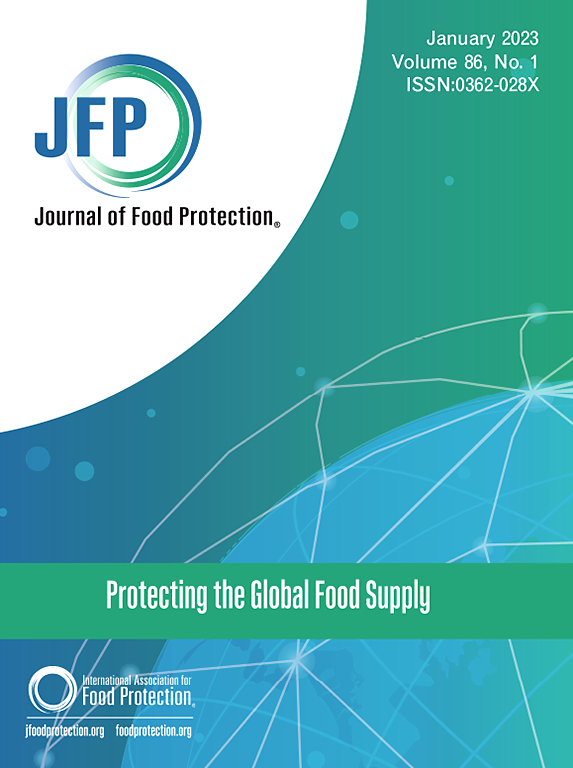Using a Dose-Response Approach on the Growth of Food–Borne Pathogens in Feces of Cattle Fed Three Different Direct-Fed Rations Reveals the Efficacy of Lactobacillus salivarius L28
IF 2.1
4区 农林科学
Q3 BIOTECHNOLOGY & APPLIED MICROBIOLOGY
引用次数: 0
Abstract
In the past two decades, the use of probiotics in livestock production has significantly increased. Direct-fed microbials (DFMs) have become popular in beef cattle production due to consumer demand for more natural meat alternatives. The objectives of this study were to (1) evaluate the dose-response of L28 at concentrations of 6, 7, and 8 log CFU/mL to inhibit the growth of STEC and S. enterica in cattle manure, and (2) assess tylosin and monensin in cattle manure and the efficacy of L28 in pathogen inhibition. Fecal samples were collected from cattle fed three different rations: (1) monensin and tylosin (MONTY), (2) monensin with L28 (MONPRO), and (3) no L28, tylosin or monensin (BASE). Sterilized fecal samples were inoculated with a cocktail mixture of three Shiga toxin-producing Escherichia coli (STEC) or Salmonella enterica (S. enterica) strains to an initial concentration of 3.0–4.0 log CFU/g. To evaluate the dose-response, Lactobacillus salivarius (L. salivarius) L28 was applied at concentrations of 6, 7, and 8 log CFU/ml. For S. enterica, the (BASE) ration had a significant treatment time effect at 12 h and 24 h with L28 at a dose of 8 log CFU (p = 0.01, p = 0.03). For STECs, the (BASE) had a similar effect, however, not significant for 24 h (p = 0.7).
A dose of 8 log CFU/mL reduced S. enterica growth in manure samples by 1.3–4.2 log CFU/g compared to BASE. While L. salivarius does not completely prevent bacterial growth, it effectively reduces foodborne pathogens. Using L. salivarius in beef products offers a natural alternative to antibiotics, benefiting both consumers and the beef industry.
用剂量响应法研究三种直接饲喂口粮的牛粪便中食源性致病菌的生长,揭示了唾液乳杆菌L28的功效。
在过去的二十年中,益生菌在畜牧业生产中的使用显著增加。由于消费者对更多天然肉类替代品的需求,直接饲养微生物(dms)在肉牛生产中变得流行。本研究的目的是:1)评估L28在6、7和8 log CFU/mL浓度下对牛粪中产志异大肠杆菌和肠链球菌生长的抑制作用;2)评估牛粪中的泰络菌素和莫能菌素以及L28对病原菌的抑制作用。分别饲喂3种不同的饲料:1.莫能菌素和莫能菌素(MONTY), 2.莫能菌素中添加L28 (MONPRO), 3.不添加L28、tylosin或莫能菌素(BASE)。用三种产志贺毒素大肠杆菌(STEC)或肠沙门氏菌(S. enterica)的鸡尾酒混合物接种消毒后的粪便样品,初始浓度为3.0 - 4.0 log CFU/g。为了评估剂量效应,分别以6、7和8 log CFU/ml的浓度施用唾液乳杆菌(L. salivarius) L28。福尔斯得到消息。在8 log CFU剂量下,(BASE)日粮在12 h和24 h对L28有显著的治疗时间效应(p = 0.01, p = 0.03)。对于STECs, (BASE)有类似的效果,但在24小时内不显著(p = 0.7)。与BASE相比,8 log CFU/mL的剂量使粪便样品中的肠球菌生长减少1.3至4.2 log CFU/g。虽然唾液乳杆菌不能完全阻止细菌生长,但它能有效地减少食源性病原体。在牛肉产品中使用唾液乳杆菌是抗生素的天然替代品,对消费者和牛肉行业都有好处。
本文章由计算机程序翻译,如有差异,请以英文原文为准。
求助全文
约1分钟内获得全文
求助全文
来源期刊

Journal of food protection
工程技术-生物工程与应用微生物
CiteScore
4.20
自引率
5.00%
发文量
296
审稿时长
2.5 months
期刊介绍:
The Journal of Food Protection® (JFP) is an international, monthly scientific journal in the English language published by the International Association for Food Protection (IAFP). JFP publishes research and review articles on all aspects of food protection and safety. Major emphases of JFP are placed on studies dealing with:
Tracking, detecting (including traditional, molecular, and real-time), inactivating, and controlling food-related hazards, including microorganisms (including antibiotic resistance), microbial (mycotoxins, seafood toxins) and non-microbial toxins (heavy metals, pesticides, veterinary drug residues, migrants from food packaging, and processing contaminants), allergens and pests (insects, rodents) in human food, pet food and animal feed throughout the food chain;
Microbiological food quality and traditional/novel methods to assay microbiological food quality;
Prevention of food-related hazards and food spoilage through food preservatives and thermal/non-thermal processes, including process validation;
Food fermentations and food-related probiotics;
Safe food handling practices during pre-harvest, harvest, post-harvest, distribution and consumption, including food safety education for retailers, foodservice, and consumers;
Risk assessments for food-related hazards;
Economic impact of food-related hazards, foodborne illness, food loss, food spoilage, and adulterated foods;
Food fraud, food authentication, food defense, and foodborne disease outbreak investigations.
 求助内容:
求助内容: 应助结果提醒方式:
应助结果提醒方式:


